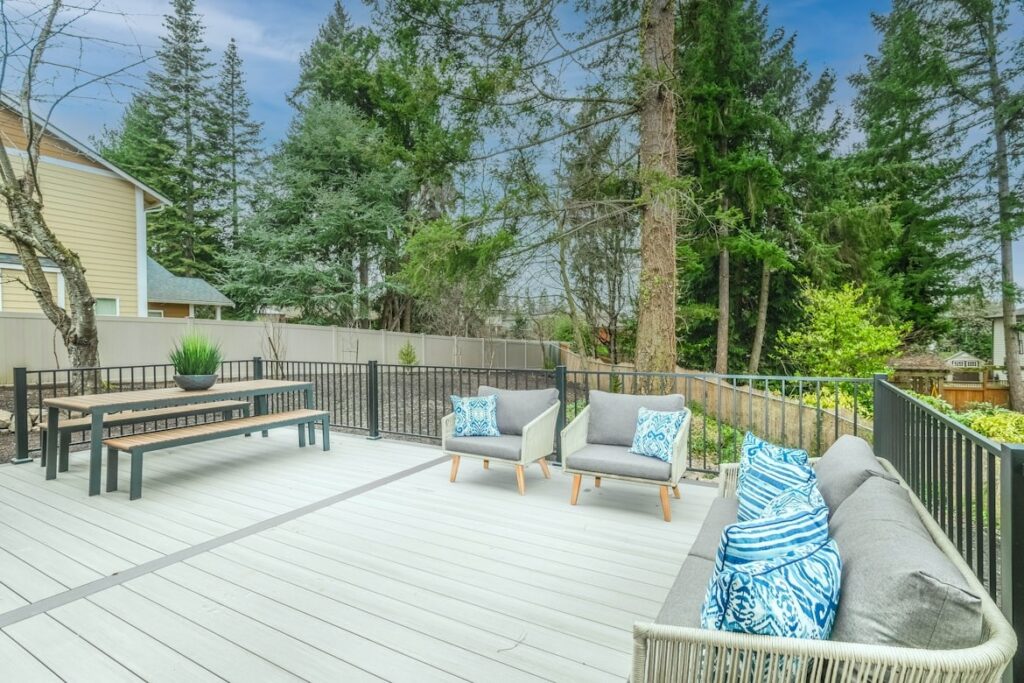The Best Low Maintenance Materials for New Decks

white wooden bench on wooden deck by Zac Gudakov is licensed with Unsplash License
Low-maintenance decking materials allow you to enjoy all the perks of the gorgeous Los Angeles weather with minimal effort. Today’s modern deck materials have garnered great popularity among homeowners who are looking for a convenient option that fits their lifestyle and their budget. At Teak Master, we’re experts in helping clients choose and maintain high-quality decks in and around Los Angeles, California.
Composite Decking
Composite decking is comprised of wood fibers held together with recycled polyvinyl chloride (PVC) or plastic binders. These boards may also come enclosed in a synthetic polymer cap. The polymer offers added protection from moisture. Composite deck materials are aesthetically similar to wood deck boards, but they don’t splinter, warp, or split. You should be aware that composite materials heat up faster than wood, so they can be painful to walk on in hot, sunny climates.
Composite decking is an extremely durable material that’s pest-resistant, easy to clean, and relatively low maintenance. Over time, composite decks fade, so you’ll see a slight change in appearance as they age. Composite decks can develop mold or mildew, so you should scrub them regularly. However, you won’t need to sand and stain them the way you do wood. You can get budget-friendly composite deck material, but it’s best to consider investing in a high-end product. Cheap composite decking doesn’t mimic the look of wood as successfully as high-quality products.
PVC Decking
PVC decking, also known as vinyl decking, is a synthetic product that’s completely bereft of wood fibers. This plastic decking is easy to clean and requires very little maintenance. You never have to stain or seal it, though you should regularly sweep and wash it like any other flooring. PVC decking is insect-proof, and some types are resistant to mold, mildew, and moisture.
PVC decks can warp and fade in the sunlight, especially if they’re exposed to a lot of heat. Though PVC doesn’t crack as easily as wood, it’s difficult to repair when it get damaged. While PVC decking is made to resemble wood, it’s obvious that this is a synthetic material.
Aluminum Decking
Aluminum decking is durable, long-lasting, and easy to clean. It stands up to mold, mildew, and insects admirably. Though you should sweep and wash your aluminum deck periodically, it doesn’t require any other maintenance. Unlike composite decks, which can get scorching hot, aluminum materials stay comfortable to the touch, even in direct sunlight.
You can find aluminum decking materials in a wide range of colors and styles to suit your aesthetic. These decks don’t fade over time, so you can rely on aluminum deck materials to maintain their appearance year after year. Aluminum decks can last for up to 60 years, which is great if you like the look of your deck.
While aluminum decks are often designed to look like wood, they’re not a very convincing replica. If you want the authentic appearance of wood decking, this isn’t the best option. Aluminum decks also make a hollow noise under footsteps and rainfall, and they ring with a loud pinging sound when debris falls on them, which is a dead giveaway that they’re not real wood.
Pressure-Treated Wood
Pressure-treated wood is made with real lumber, so you don’t have to worry about whether it’ll pass for wood. This type of lumber is infused with chemicals in a high-pressure tank. These chemicals help prevent pest infestations and rot. Pressure-treated wood should last longer than untreated lumber, but this depends largely on the type of wood you use.
If you’re looking for an affordable deck material that’s made from real wood, pressure-treated lumber is one of the best options. The low price tag means that you can easily replace pieces if they splinter, crack, or warp, which is possible with this type of wood. You’ll need to regularly clean and seal a pressure-treated wood deck, so it’s not as low-maintenance as synthetic wood products. Pressure-treated decking should last for around 40 years, though its life span can be shorter, particularly when it’s not well cared for.
Ipe Wood
Ipe is one of the strongest and most resilient woods that you can use for your decking. It’s an incredibly dense Brazilian hardwood that can last for as long as 70 years. Because Ipe is so dense, it’s difficult for anything to penetrate it, including mildew, water, and insects. This means that it’s unlikely to rot or scratch. It also has a Class-A fire rating because it’s so dense that it’s hard to burn.
As with any deck, you should sweep and clean your Ipe decking regularly. Ipe takes on a natural gray patina when exposed to the sun. If you don’t like this aesthetic, you can protect your Ipe by sealing it annually. You must use a product that’s formulated for Ipe or the sealer won’t be able to penetrate your deck.
You’ll probably want to have your Ipe refinished every few years to keep it looking fresh. Our team members at Teak Master are experts in restoring and refinishing Ipe. We can bring it back to its original brown hue if you have an unwanted gray patina. We also clean, sand, and seal the decking to refresh it.
Expert Recommendations for Your Deck
If you’re building a new deck, our knowledgeable staff at Teak Master can give you personalized recommendations on the best low-maintenance materials for your home. We have years of experience in cleaning and restoring decks throughout the Orange County area. We understand the extreme pleasure that you can get from having a beautiful deck with such gorgeous weather throughout the year, and we’re familiar with the unique challenges of the climate. Contact us now to learn more about how we can help with your decking project.
